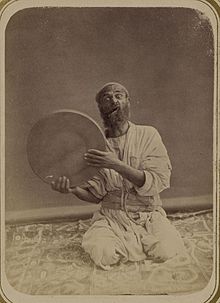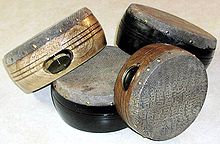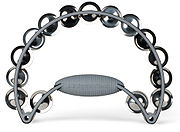Tambourine: Difference between revisions
m Removing "Pandei_inter.jpg", it has been deleted from Commons by Sreejithk2000 because: Per commons:Commons:Deletion requests/File:Pandei inter.jpg. |
No edit summary |
||
| Line 84: | Line 84: | ||
{{main|Daf}} |
{{main|Daf}} |
||
[[File:Daf-isfahan.jpg|thumb|left|An Iranian woman playing a frame drum, from a painting on the walls of ''Chehel-sotoon'' palace, [[Isfahan (city)|Isfahan]], 17th century, [[Iran]].]] |
[[File:Daf-isfahan.jpg|thumb|left|An Iranian woman playing a frame drum, from a painting on the walls of ''Chehel-sotoon'' palace, [[Isfahan (city)|Isfahan]], 17th century, [[Iran]].]] |
||
A '''daf''' is a large-sized tambourine used to accompany both popular and classical music in [[Iran]], [[Azerbaijan]], [[Turkey]] (where it is called ''tef''), [[Uzbekistan]] (where it's called ''childirma''), [[India]] (where it is known as the ''Dafli'') |
A '''daf''' is a large-sized tambourine used to accompany both popular and classical music in [[Iran]], [[Azerbaijan]], [[Turkey]] (where it is called ''tef''), [[Uzbekistan]] (where it's called ''childirma''), [[India]] (where it is known as the ''Dafli'') and [[Turkmenistan]]. Daf typically indicates the beat and tempo of the music being played, thus acts like the conductor in the monophonic oriental music. The Persian poet [[Rudaki]], who widely used names of the musical instruments in his poems, mentions the daf and the tambourine (taboorak) in a [[Ruba'i]]: |
||
==Kanjira== |
==Kanjira== |
||
Revision as of 09:28, 3 June 2012
| Percussion instrument | |
|---|---|
| Other names | Riq, Buben |
| Classification | hand percussion |
| Hornbostel–Sachs classification | 112.122(+211.311, with drumhead) (Indirectly struck idiophone, sometimes including struck membranophone) |
| Playing range | |
| High sound of jingles, plus some have a skin with a lower sound. | |
| Related instruments | |
| Riq, Buben, Dayereh, Daf, Kanjira, Frame drum | |
The tambourine or marine (commonly called tambo) is a musical instrument in the percussion family consisting of a frame, often of wood or plastic, with pairs of small metal jingles, called "zils". Classically the term tambourine denotes an instrument with a drumhead, though some variants may not have a head at all. Tambourines are often used with regular percussion sets. They can be mounted, but position is largely down to preference.
Tambourines come in many different shapes with the most common being circular. It is found in many forms of music: Greek folk music, Italian folk music, classical music, Persian music, gospel music, pop music and rock music. The word tambourine finds its origins in French tambourin, which referred to a long narrow drum used in Provence, the word being a diminutive of tambour "drum," altered by influence of Arabic tunbur "drum".[1] from the Middle Persian word tambūr "lute, drum".[2]
According to Phil Collins it is the most important instrument in Motown.[citation needed]
Playing
The tambourine can be held in the hand or mounted on a stand, and can be played in numerous ways, from stroking or shaking the jingles to striking it sharply with hand or stick or using the tambourine to strike the leg or hip.
Tambourine rolls
There are several ways to achieve a tambourine roll. The easiest method is to rapidly rotate the hand holding the tambourine back and forth, pivoting at the wrist.
Thumb roll
An advanced playing technique is known as the thumb roll. The finger or thumb is moved over the skin or rim of the tambourine, producing a fast roll from the jingles on the instrument. This takes more skill and experience to master.
The thumb or middle finger of the hand not holding the tambourine is run around the head of the instrument approximately one centimeter from the rim with some pressure applied. If performed correctly, the thumb should bounce along the head rapidly, producing the roll. Usually, the end of the roll is articulated using the heal of the hand or another finger.
Today the thumb roll is performed with the use of wax or resin applied to the outside of the drum head. This resin allows the thumb or finger to bounce more rapidly and forcefully across the head producing an even sound. A continuous roll can be achieved by moving the thumb in a figure of 8 pattern around the head.
-
Ancient Greek black-figure pottery depicting a girl playing the tambourine. Bourgas Archaeology Museum.
-
Woman holding a mirror and a tambourine facing a winged genie with a ribbon and a branch with leaves. Ancient Greek red-figure oinochoe, ca. 320 BC, from Magna Graecia. (Notice the coloured decorative woven stripes hanging on the tambourine, which can still be seen today on "tamburello", the tambourine of Southern Italy.)
-
Girl playing a tambourine. Detail from Recreation (1896), by Charles Sprague Pearce. Library of Congress Thomas Jefferson Building, Washington, D.C.
-
Rhythm Tech tambourine
In popular music
This section needs expansion. You can help by adding to it. (January 2012) |
In rock music, a tambourine is most often played:
- Lead singers Jim Morrison,Robert Plant and Liam Gallagher have both been known to use a tambourine while singing.
- Many drummers such as Larry Mullen mount a tambourine above the cymbals of their hi-hat stand; Others mount it elsewhere.
Tambourines in rock music are most often headless, a ring with jangles but no skin. The Rhythm Tech crescent shaped tambourine and its derivatives are particularly popular. The original Rhythm Tech tambourine is displayed in the Museum of Modern Art.
Pandeiro
Originated in Portugal, the pandeiro was brought to Brazil by the Portuguese settlers. It is a hand percussion instrument consisting of a single tension-headed drum with jingles in the frame. It is very typical of more traditional brazilian music
Panderoa
The Basque pandero is a folk instrument currently played along with the diatonic accordion in a duo most of the times. Sometimes the players, who play in festivities to enliven the atmosphere or less frequently at onstage performances, sing along. At times the pandero accompanies the alboka or txistu too. Yet this kind of duos have not always been the case. As attested in 1923, the youth gathered to dance to the rhythm of the bare pandero, with no other music instrument implicated but the player's (a woman's) voice.
Riq

The riq (also spelled riqq or rik) is a type of tambourine used as a traditional instrument in Arabic music. It is an important instrument in both folk and classical music throughout the Arabic-speaking world. Widely known as "Shakers".
Buben
Buben (Бубен in Russian, Бубон in Ukrainian, boben in Slovenian, buben in Czech, bęben in Polish) is a musical instrument of the percussion family similar to a tambourine. A buben consists of a wooden or metal hoop with a tight membrane stretched over one of its sides (some bubens have no membrane at all). Certain kinds of bubens are equipped with clanking metal rings, plates, cymbals, or little bells. It is held in the hand and can be played in numerous ways, from stroking or shaking the jingles to striking it sharply with hand. It is used for rhythmical accompaniment during dances, soloist or choral singing. Buben is often used by some folk and professional bands, as well as orchestras.
The name is related to Greek language βόμβος (low and hollow sound) and βομβύλη (a breed of bees) and related to Indo-Aryan bambharas (bee) and English bee.
Buben is known to have existed in many countries since time immemorial, especially in the East. There are many kinds of bubens, including def, daf, or qaval (Azerbaijan), daf or khaval (Armenia), daira (Georgia), doira (Uzbekistan and Tajikistan), daire or def (Iran), bendeir (Arab countries), pandero (Spain). In Kievan Rus, drums and military timpani were referred to as buben.
Dayereh

A dayereh (or doyra, dojra, dajre, doira, daire) is a medium-sized frame drum with jingles used to accompany both popular and classical music in Iran (Persia), the Balkans, and many central Asian countries such as Tajikistan and Uzbekistan. It is a percussion instrument, and is something intermediate between a drum and a tambourine.
Daf

A daf is a large-sized tambourine used to accompany both popular and classical music in Iran, Azerbaijan, Turkey (where it is called tef), Uzbekistan (where it's called childirma), India (where it is known as the Dafli) and Turkmenistan. Daf typically indicates the beat and tempo of the music being played, thus acts like the conductor in the monophonic oriental music. The Persian poet Rudaki, who widely used names of the musical instruments in his poems, mentions the daf and the tambourine (taboorak) in a Ruba'i:
Kanjira

The kanjira or ganjira is a South Indian frame drum of the tambourine family. It is mostly used in Carnatic music concerts (South Indian classical music) as a supporting instrument for the mridangam.
Timbrel

Timbrel or tabret (the tof of the ancient Hebrews, the deff of Islam, the adufe of the Moors of Spain), the principal musical instrument of percussion of the Israelites, similar to the modern tambourine.
Rabana
A Rabana (plural Raban) is a one-sided traditional tambourine played with the hands, used in Sri Lanka.
Rebana
Rebana is a Malay tambourine that is used in Islamic devotional music in Southeast Asia, particularly in Indonesia, Malaysia, Brunei, and Singapore.
See also
References
External links
- Chisholm, Hugh, ed. (1911). . Encyclopædia Britannica (11th ed.). Cambridge University Press.
- Ancient Greek musical instruments
- Greek musical instruments
- Russian musical instruments
- Iranian musical instruments
- Turkish musical instruments
- Indian musical instruments
- Marching percussion
- Early musical instruments
- Russian folk music
- Ukrainian musical instruments
- Belarusian musical instruments
- Bosnian musical instruments
- Latin percussion
- Hungarian musical instruments
- Tajik musical instruments
- Portuguese musical instruments
- Slovenian musical instruments
- Czech musical instruments
- Polish musical instruments
- Macedonian musical instruments
- Ancient Egyptian musical instruments
- Idiophones
- Membranophones
- Orchestral percussion
- Drum kit components
- Hand percussion
- Hand drums





